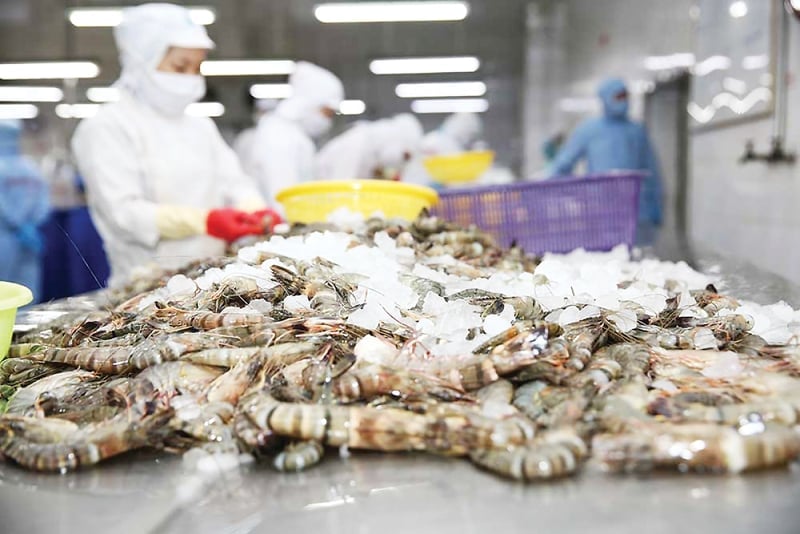November 11, 2025 | 05:09 GMT +7
November 11, 2025 | 05:09 GMT +7
Hotline: 0913.378.918
November 11, 2025 | 05:09 GMT +7
Hotline: 0913.378.918

Early May brought many positive signals for Vietnam’s shrimp industry. Photo: VASEP.
May saw many positive signals for Vietnam’s shrimp industry, with significant increases in both volume and value in major export markets. However, according to the Vietnam Association of Seafood Exporters and Producers (VASEP), the outlook for the second half of the year still carries many risks, especially due to the wait-and-see attitude of importers while U.S. tariff policy, which is Vietnam’s largest market, remains unresolved.
In addition, exchange rate fluctuations between the U.S. dollar and the Vietnamese dong are having a noticeable impact on production and export costs. Some businesses reported that rising input costs have narrowed profit margins, particularly for fixed-price orders signed earlier in the year.
According to data from VASEP, in May, export volume of whiteleg shrimp reached 30,089 tons, up 23% compared to April and 6% higher than the same period last year. Key products included headless boiled shrimp, frozen peeled tail-on shrimp, sushi shrimp, steamed shrimp, and battered fried shrimp with sauce, which are tailored to the needs of restaurant, retail, and ready-to-eat food segments.
Exporting companies have proactively adjusted their business strategies, focusing on deeply processed and high-value-added products to cope with market fluctuations and increasing competition from countries such as Ecuador, India, and Thailand.
Notably, the U.S. was the fastest-growing market, with shrimp imports from Vietnam reaching 7,060 tons, up 72% from the previous month. This is the highest level since October 2024. The average export price to this market was USD 11.60 per kilogram, a slight increase of 0.9%. China also increased its imports to 4,500 tons, although the average price dropped 3% to USD 6.50 per kilogram.
Other markets recorded steady growth: South Korea up 20%, the EU up 14%, Japan up 3%, while the UK saw a slight decline of 5%. The average export price for whiteleg shrimp across all markets was USD 9.00 per kilogram, up 1% from the previous month. Domestic raw shrimp prices also increased by 5–7% due to higher demand from processing plants.
However, with rising raw shrimp prices, some small-scale processing plants are facing financial difficulties in maintaining operating capacity. As a result, they are forced to cut production hours or temporarily halt procurement.
In the first five months of the year, leading whiteleg shrimp exporters included: STAPIMEX, Minh Phu Hau Giang, Sao Ta, Minh Phu, and Cases.
These companies not only maintained strong market shares but also continued to invest in upgrading processing technologies, expanding freezing capacity, and automating production lines to reduce costs and better meet large international orders.
In the premium segment, black tiger shrimp continued to grow with a volume of 4,353 tons in May, up 8% from April and 6% year-on-year. Key products included PTO/PDTO headless shrimp, whole shrimp, frozen peeled shrimp, steamed shrimp, and HLSO.
The U.S. also sharply increased imports of black tiger shrimp, reaching 600 tons at the highest price point of USD 17.10 per kilogram. Japan imported 886 tons, with prices up 6% to USD 12.40 per kilogram. The EU imported 390 tons, marking the fourth consecutive month of increase, although the price slightly dropped by 6.1% to USD 10.70 per kilogram.
Some markets adjusted prices. South Korea sharply reduced import prices by 30% to USD 8.30 per kilogram, while China maintained a stable volume at 1,300 tons but lowered prices by another 3.3% to USD 8.90 per kilogram. Overall, the average export price of black tiger shrimp reached USD 11.82 per kilogram, up 4%.
However, domestic raw shrimp production showed signs of slowing, down 2% to about 24,000 tons. The supply of large-sized shrimp was abundant, leading to price adjustments by size: black tiger shrimp size 20–40 pieces per kilogram dropped 2%, size 50 pieces per kilogram remained stable, while size 80 pieces per kilogram fell 9%.
According to VASEP, Vietnamese black tiger shrimp currently holds significant advantages in premium markets such as Japan, the EU, and Switzerland, where consumers prioritize eco-friendly, mangrove-raised, traceable, and sustainably certified products.
In addition, black tiger shrimp exporters are leveraging free trade agreements (FTAs) to reduce import tariffs, thereby enhancing competitiveness against rivals from India, Bangladesh, and Indonesia.
The continued promotion of scientific and technological applications, improved breeding practices, and sustainable pond management will be key to helping Vietnam’s shrimp industry maintain growth and enhance export value in the coming months.
However, competitive pressure from India is increasing, especially as the country expands its two-crop black tiger shrimp farming model in Andhra Pradesh, which targets the small-sized shrimp segment in the Asian market.
Translated by Huong Giang

(VAN) The Vietnamese tilapia industry is only in the initial stages of export, yet its growth potential remains vast. To reach further, it needs to focus on breed stock, technology, and deep processing.
/2025/11/08/3402-1-212706_176.jpg)
(VAN) Viet Nam's fruit and vegetable exports continued to reach an extremely high turnover in October. With this growth momentum, the sector is expected to set a new milestone of USD 8.5 billion in 2025.
/2025/11/08/4950-1-163820_289.jpg)
(VAN) During the 2021–2025 period, Viet Nam's agro-forestry-fishery processing industry has made remarkable progress, achieving an average growth rate of 8%/year.

(VAN) Over 80 years, Vietnamese rice has journeyed through half a century to become a symbol of knowledge, resilience, and the new nation’s agriculture stature.

(VAN) The traders estimated that the lowest price in the tender, closed on Thursday by Bangladesh's state grain buyer, to buy 50,000 metric tonnes of rice was $355.59 per metric ton CIF, liner out.

(VAN) The information shared by Dr. Ngo Xuan Nam, Deputy Director of Viet Nam Sanitary and Phytosanitary Notification Authority and Enquiry Point (SPS Viet Nam), on October 30 during a conference on food safety regulations.

(VAN) Viet Nam mainly exports raw Bat Do bamboo shoots for deep processing, so premium products appear only on dining tables in Japan and Taiwan.